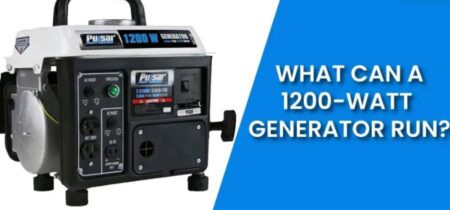
In the 21st century, power generators are commonplace instruments that offer us reliable and transportable electrical sources when we need them the most. Power generators have proven to be useful pieces of equipment, whether they’re used for backup power during emergencies or for outdoor activities like camping.
But what exactly is a power generator and how does it work? We’ll step into the world of power generators in this blog and examine all of its kinds, application guide, and maintenance. Let’s get started without further ado.
What is a Power Generator?
A device that transforms mechanical energy into electrical energy is a power generator. In most cases, an engine powers a generator, which subsequently generates electricity. Depending on the type of generator, the engine can run on a range of fuels, including gasoline, diesel, natural gas, or propane.
Power generators are used for several purposes such as powering construction sites and outdoor events as well as supplying backup power during power outages. From small portable units that can run a few appliances to big stationary generators that can power an entire building, they’re available in a variety of shapes and sizes.
Electromagnetic induction serves as the basic planning of a power generator. A magnetic field is formed around a coil of wire as the engine turns the generator, which causes an electric current to flow through the wire. Then, this current can be captured and used to run electrical machinery.
Types of Power Generator
When it comes to power generators, there are several types to choose from. Each type has its own unique features and benefits, making it important to consider your specific needs before making a purchase. Here are five of the most common types of power generators:
- Portable generators: As the name suggests, portable generators are designed to be moved easily from one place to another. They’re smaller and less powerful than stationary generators, making them an ideal for outdoor activities like camping or tailgating. Portable generators are powered by gasoline or propane and can provide enough power to run small appliances, lights, and electronic devices.
- Stationary generators: Stationary generators are designed to be permanently installed in a specific location such as a home or business. They’re more powerful than portable generators and are capable of providing enough power to run an entire building. Stationary generators are usually powered by natural gas or propane and can automatically switch on in the event of a power outage.
- Inverter generators: Inverter generators are more fuel-efficient and produce cleaner power than traditional generators. They use advanced electronics to regulate the generator’s output, making them ideal for powering sensitive electronics like laptops and smartphones.
- Standby generators: Standby generators are similar to stationary generators in that these generators are designed to be permanently installed in a specific location. However, they’re much more powerful and can provide enough power to run an entire neighborhood. Standby generators are also capable of automatically switching on in the event of a power outage.
- RV generators: RV generators are specifically designed for use in recreational vehicles, such as motorhomes or travel trailers. They’re typically smaller and less powerful than other types of generators, but are still capable of providing enough power to run the RV’s appliances and electronic devices. RV generators are usually powered by gasoline or propane.
Each type of power generator has its own unique features and benefits, making it important to consider your specific needs before making a purchase. Factors to consider include power output, fuel type, portability, and noise level.
Why do You need a power generator
There’s several reasons why you may need a power generator. One of the most common reasons is for backup power during power outages. This is particularly important for those who live in areas that are prone to extreme weather conditions, such as hurricanes or snowstorms, where power outages can last for days or even weeks. A power generator can help keep your home or business running during these times, allowing you to keep your lights on, your appliances running, and your electronic devices charged.
Another reason you may need a power generator is for outdoor activities like camping, tailgating, or outdoor events. In these situations, a portable generator can provide you with the convenience of electricity without having to rely on electrical outlets or extension cords. It can power everything from lights and fans to appliances and electronics, making your outdoor experience much more enjoyable and comfortable.
Power generators can also be essential in industrial settings, such as construction sites or remote locations where grid power is not available. They can power heavy machinery and tools, helping to increase productivity and efficiency.
How to Use a Power Generator? A Step-by-Step Guide
Here’s a step-by-step guide on how to use a power generator:
- Read the manufacturer’s instructions: Before operating your power generator, make sure to read the manufacturer’s instructions carefully. This will help you to understand the generator’s specific features, maintenance requirements, and safety precautions.
- Choose the right location: Ensure that the generator is placed in a well-ventilated and dry area, away from any flammable materials, such as gasoline or propane tanks.
- Check fuel and oil levels: Make sure that there is enough fuel and oil in the generator before starting it up. Refer to the manufacturer’s instructions to determine the appropriate fuel and oil type and the recommended levels.
- Turn the fuel valve on: Turn the fuel valve on and make sure the choke is in the correct position.
- Start the generator: Pull the starter cord or press the electric start button to start the generator. Allow the generator to warm up for a few minutes before connecting any devices.
- Connect your devices: Use extension cords to connect your devices to the generator’s outlets. Make sure to use cords that are rated for the power output of the generator and that they’re properly grounded.
- Turn on your devices: After connecting your devices, turn them on one by one. This will help prevent the generator from being overloaded.
- Monitor the generator: Keep an eye on the generator’s fuel and oil levels and check for any signs of overheating or other issues. If you notice any problems, turn off the generator immediately and address the issue before restarting it.
- Turn off the generator: Once you’re done using the generator, turn off any connected devices and then the generator itself. Allow the generator to cool down before storing it in a dry, well-ventilated area.
How does a Power Generator Work (Simple)?
Mechanical energy is transformed into electrical energy by a power generator. The power generator usually comes with an engine and a generator as its two major parts. Other fuels like gasoline or diesel, can power the engine. A rotor within the generator spins when the engine is operating, producing a magnetic field surrounding a coil of wire. An electrical current is produced in the wire as a result of the magnetic field. Then, this current can be captured and used to run electrical appliances and lighting. In conclusion, the generator is powered by the engine, which produces an electrical current that may be utilized to power various devices.
Maintaining your Power Generator
To ensure your power generator operates at its best and lasts a long time, it’s essential to perform regular maintenance and inspections. Here are some key maintenance tasks to keep in mind
- Regular Maintenance and Inspections
Regularly inspecting your generator and performing routine maintenance tasks can help prevent breakdowns and ensure that your generator is ready to use when you need it. Here are some maintenance and inspection tasks to consider:
- Check fuel and oil levels regularly
- Inspect air filters and clean or replace them as needed
- Check spark plugs and replace them if worn or dirty
- Check battery connections and clean them if they’re corroded
- Inspect the generator’s wiring and electrical connections for signs of damage or wear
- Test the generator’s automatic transfer switch (if it has one) to ensure it’s working properly
- Inspect the generator’s fuel lines, fuel filter, and carburetor and clean or replace them as needed
- Changing Oil and Filters
One of the most important maintenance tasks for your power generator is changing its oil and filters regularly. Here are some tips to keep in mind:
- Follow the manufacturer’s instructions for oil and filter changes
- Change the oil and filter after the first 20 hours of use, and then every 100 hours or annually thereafter (whichever comes first)
- Use the recommended oil and filter type specified by the manufacturer
- Make sure to dispose of the used oil and filter properly, according to local regulations
- Storing the Generator Properly
Properly storing your generator when it’s not in use can help prevent damage and extend its lifespan. Here are some storage tips to keep in mind:
- Clean the generator thoroughly before storing it
- Drain any remaining fuel from the tank and carburetor
- Store the generator in a dry, well-ventilated area away from direct sunlight
- Cover the generator with a protective cover to prevent dust and debris from accumulating
- Check the generator periodically during storage to ensure that it’s still in good condition
- By performing these maintenance tasks regularly and storing your generator properly, you can help ensure that it’s ready to use when you need it most.
Conclusion
Power generators provide us stable, portable sources of electricity when we need them the most. Power generators have established themselves as adaptable and practical tools, whether used for outdoor activities like camping or as backup power during emergencies.
We can maximize the benefits of power generators and preserve their life span by being aware of how they operate and adhering to appropriate safety precautions. Hence, whether you’re looking for a generator for home or business usage, bear in mind to pick the proper kind and size, give it regular maintenance, and always use it carefully. You can be confident that you’ll never be left in the dark if you have a power generator nearby.
Also Read:









